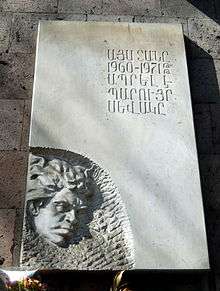Paruyr Sevak
| Paruyr Sevak | |
|---|---|
 | |
| Born |
Paruyr Ghazaryan January 24, 1924 Chanakhchi, Soviet Armenia |
| Died |
June 17, 1971 (aged 47) near Yerevan |
| Resting place | Zangakatun, Armenia |
| Nationality | Armenian |
| Period | 1940s-1971 |
| Notable works | We Are Few but We Are Called Armenians, The Unsilenceable Belfry, Man in a Palm, Immortals Command |
| Spouse | Maya Avagyan, Nelly Menagharishvili |
| Website | |
|
www | |
Paruyr Sevak (Armenian: Պարույր Սևակ) (January 24, 1924 – June 17, 1971) was an Armenian poet, translator and literary critic. He is considered one of the greatest Armenian poets of the 20th century.[1]
Biography
Sevak was born Paruyr Ghazaryan (Armenian: Պարույր Ղազարյան) in Chanakhchi (now Zangakatun) village, Armenian SSR, Soviet Union to Rafael Ghazaryan and Anahit Soghomonyan on January 24, 1924. Young Paruyr attended the village school and later in 1940 moved to Yerevan to study at the philological faculty of Yerevan State University. He graduated from the YSU in 1945.[2] The same year he starts a postgraduate study of Armenian literature at the Academy of Sciences Abeghyan Institute of Literature.[2] In 1951 Sevak went to Moscow to study at the Gorky Institute of World Literature.[2] Graduating from that institute Paruyr works there in 1957-59 as a translating professor.
Inspired by the Western Armenian poet Ruben Sevak, Paruyr Ghazaryan adopted the name Paruyr Sevak as his pen name.
In 1960 Sevak returns to Yerevan and starts his fecund and meaningful literary, scientific and public activism.[2] He starts to work at the Abeghyan Institute of Literature as a scientific researcher.[2] From 1966-1971 Sevak served as the Secretary of the Board of the Writers Union of Armenia.[2]
In 1967 Sevak became a doctor of philology after dissertation defense.[2] In 1968 he was elected to the Supreme Council of the Armenian SSR.[2]

Sevak died on June 17, 1971 in a car crash while on a drive back to Yerevan.[2] In previous years, he had voiced his criticism of the corruption of the Soviet establishment and for this, many Armenians believe, he was murdered by the Soviet government.[3] His wife, Nelly Menagharishvili, also died in the car crash. He was buried in the backyard of his home, in Zangakatun, which later became a museum open to everyone.
Literary work
Sevak's poem The Unsilenceable Belfry is dedicated to Armenian composer Komitas Vardapet and to the remembrance of the Armenian Genocide.
Publications
- Immortals Command (Անմահները հրամայում են) — 1948
- Uncompromising Intimacy (Անհաշտ մտերմություն) — 1953
- Love Road (Սիրո ճանապարհ) — 1954
- The Unsilenceable Belfry (Անլռելի Զանգակատուն) — 1959
- Man in a Palm (Մարդը ափի մեջ) — 1964
- Sayat Nova (Սայաթ Նովա) — 1969
- Let There Be Light (Եղիցի լույս) — 1969
- Your Acquaintances (Ձեր ծանոթները) — 1971
Legacy and memory
One of the mains streets of Yerevan's Kanaker-Zeytun district is named after Sevak.[4] School #123 of Yerevan is named after Paruyr Sevak.[5]
In popular culture
- "Paruyr Sevak" (1984) directed by Levon Mkrtchyan, Armenfilm
References
- ↑ Portraits of hope: Armenians in the contemporary world, by Huberta von Voss - 2007 - p. 116
- 1 2 3 4 5 6 7 8 9 Կենսագրություն (in Armenian). ParuyrSevak.com. Retrieved August 3, 2012.
- ↑ Malkasian, Mark (1996). Gha-ra-bagh!: The Emergence of the National Democratic Movement in Armenia. Detroit: Wayne State University Press. p. 215. ISBN 9780814326046.
- ↑ "Sevak St, Yerevan, Armenia". Google Maps. Retrieved August 2, 2012.
- ↑ "YEREVAN BASIC SCHOOL №123 NAMED AFTER PARUYR SEVAK". Spyur: Company Register of Armenia. Retrieved August 2, 2012.
External links
- Paruyr Sevak
- Paruyr Sevak
- Paruyr Sevak
- Paruyr Sevak's poems translated in English on Goodreads
- Sevak`s poetries audio version
- Dedicated site